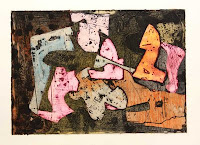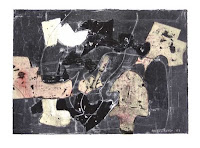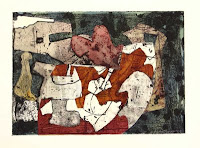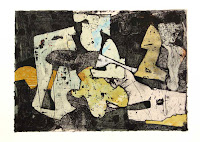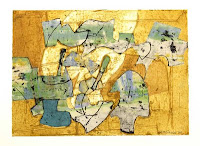

More than two centuries ago in the history of lithography, natural stone was brought to the printing press. On August 4th and 5th last year, however, for the first time it was the other way around, and, as a result, the world biggest lithography was produced.
In the quarry Siebenbuchenplatz of the company SBI, in the famous region of Solnhofen, in Germany, (where the Archaeopteryx was found) the artist Mario Derra produced an art print, which has an enormous size of 12 x 1.24 meters. Until this time lithographs had been limited to poster sizes, because only the fine and dense structure of Solnhofener plated limestone can be used for this technique and this material can be quarried only in limited formats.
This was because Derra left his studio and decided to print directly in the quarry.
First a suitable stone bank was smoothed out with hammer and chisel, then the surface was honed with an Italian Terrazzo Honing Machine. Finally, Derra could draw his work of art named "Mass Tourism at the Twelve Apostles" on the stone. With a self-constructed, drivable press, filled with one ton of stones, the twelve meters were rolled of under the continuous observation of Master Derra.
The prints show a scene of about 100 locusts, as they can be found very often as fossils in the limestone of Solnhofen, in front of a rock formation called the Twelve Apostles. This work of art reminds - says Derra - of the rich fossil treasure of the region on the one hand, but is also an ironical view on the mass tourism in that region.
The project has been one of the high spots in the German "Year of the Geological Science". The printing was limited to only 20 lithographs, which are distributed to museums all over Germany. The printing plate was rescued and will be exhibited together with one of the prints in the local museum. Also exhibited in the museum is the history of the inventor of lithography, Alois Senefelder, who invented this technology in 1798.
 Professor James Bailey and advanced printmaking students with Drive By Press artists Joseph Velasquez and Drew Iwaniw.
Professor James Bailey and advanced printmaking students with Drive By Press artists Joseph Velasquez and Drew Iwaniw.  Students viewing large scale relief print.
Students viewing large scale relief print.  Students viewing a few of the hundreds of prints on display.
Students viewing a few of the hundreds of prints on display.  Print graduate student Steph Johnsen, with relief printed T-shirt.
Print graduate student Steph Johnsen, with relief printed T-shirt.  Students also visited the Jundt Art Museum Print Archives, where they viewed original prints by such artists as Chuck Close, Pablo Picasso (whose work is pictured above), along with prints by Glen Alps, Albrect Durer, Kathe Kollowitz and numerous others. Click here for more info on Drive By Press.
Students also visited the Jundt Art Museum Print Archives, where they viewed original prints by such artists as Chuck Close, Pablo Picasso (whose work is pictured above), along with prints by Glen Alps, Albrect Durer, Kathe Kollowitz and numerous others. Click here for more info on Drive By Press. 



















